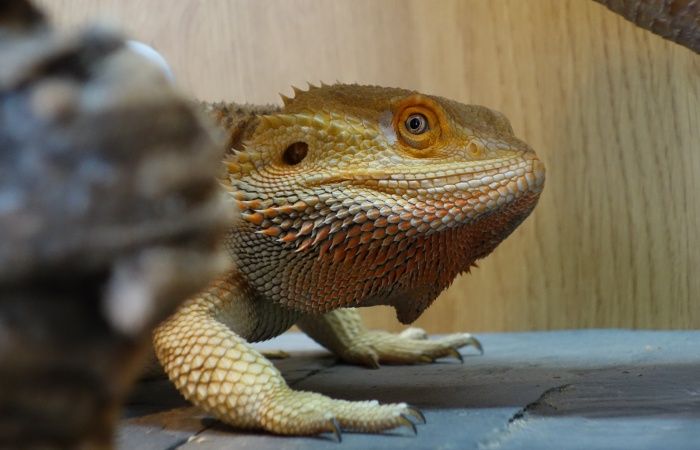Bearded Dragon Information Pogona vitticeps |
 |
|---|---|
| Taxonomy | |
| Kingdom | Animalia |
| Class | Reptilia |
| Family | Agamidae |
| Sub family | Agaminae |
| Genus | Pogona |
| Species | P. vitticeps |
| Scientific name | Pogona vitticeps |
| Facts | |
| Origin | Central australia |
| Size | 20 - 24 inches |
| Tank size | 48" w x 24" h x 24" d |
| Tank type | Vivarium |
| Colours | Sandy, yellow, orange, red, white |
| Diet | Live insects and vegetables/salad |
| Lifespan | 7 - 10 years |
Bearded Dragons originated in Central Australia; they make fantastic family pets and are not difficult to keep once you have the correct knowledge and equipment.
Visit the Bearded dragon care page for tips, facts and advice which can be used to keep your bearded dragon happy and healthy.
From the vivarium setup needed, to the breeding of bearded dragons, I researched everything I could before buying my first dragon, 'Stumpy'. Since owning him, I have found that certain pet shops and leaflets do not always provide information that is entirely correct, so I decided to collate the knowledge I have gained into a useful set of factual information pages that can be used as a reference for others.
My Dragon
His name is Stumpy and I bought him from my local pet shop many years ago now. I chose his name because he lost the tip of his tail when he was small! At the pet shop, this little guy was racing around the vivarium, and when the staff got him out for me to handle, he launched himself from my hands and ran around the shop for a couple of minutes! When you make your selection, I would advise selecting an alert, active bearded dragon; try and watch them feed and make sure everything else seems to be normal. So long as it is of a good size, eating and pooping well and is nice and active, it should be healthy and will be able to cope with the stressfull period of settling in to its new home.
A little research will show you that you can expect your bearded dragon to have an adjustment period of one or two weeks as it settles in. During this time, it may not eat much and can be rather skittish, but fresh salad and water should be offered daily anyway.
When I bought Stumpy, I expected him to be a bit grumpy for a week or so, although fortunately enough, the next day he was already eating live food and a little salad whilst continuing to race around – and he has fed non-stop ever since!
Advice and Research
Before purchasing a bearded dragon, do your research! Getting the right equipment, maintaining the correct levels of heating and lighting, and instating a proper feeding routine are all essential to keeping your bearded dragon happy and healthy for a long time. As previously mentioned, bearded dragons can sulk and become unhappy when their surroundings are changed. Warning! If your heat gradient and feeding regime is incorrect, you can potentially lose your dragon. It may take time and patience to get it absolutely right but it will worth it – I managed to sort it out in two days using a couple of different wattage bulbs to achieve the correct temperatures.
Click the links for more specific information regarding vivarium Heating and Lighting.
Initial Setup and Equipment
When I started out I purchased the minimum requirements for keeping a bearded dragon:
Vivarium
Water and food dish
Basking bulb and adapter
UVB flourescent tube and lighting controller
Substrate
Basking rock or log
Calcium powder
Decorations (optional)
A word of warning – all of the above are fairly costly, and on top of this, with a baby beardy, you must buy live food regularly. This is an essential requirement, and again is another outlay which can be expensive, especially if you choose to feed locusts.
For more detailed information on what you should buy for your beardy, which you must consider BEFORE purchasing your dragon, please see the vivarium setup section.
Upgrading my Vivarium/Enclosure
As previously mentioned, I initially purchased the minimum amount of equipment required; this included a 3ft x 2ft x 2ft (90cm x 60cm x 60cm) enclosure, which was fine while he was young. Now he has grown much larger and needs much more space to move around and exercise.
The minimum size vivarium recommended for a fully grown bearded dragon is at least 4ft (120cm) in length. Dragons are semi-arboreal – they also like climbing – although experts will tell you floor area and space is more important!
As he grew, I therefore bought a larger enclosure for Stumpy that is 4ft (120cm) long, 3ft (90cm) high and 2ft (60cm) deep. The major issue with this enclosure was getting the temperatures correct, providing enough UVB light at a safe distance and making sure it provided a safe environment.
The basking spot is at a height of approximately 1.75ft (52cm), and I created a rock background to do this (page under construction). The temperature was easy to get perfect on the basking spot, although regulating temperatures in the middle of the enclosure and at the cooler end was more of a challenge!
Common questions below Click on the links for answers to your Beaded Dragon questions
What size vivarium for a bearded dragon? 3ft vivarium for a bearded dragon?
What temperature should the basking spot be? Should I use a heat mat with a bearded dragon?
What lighting should I use? What is UVB lighting? What bulb for basking?
Should I breed my dragon?
What should I feed my bearded dragons? Which vegetables? How often? What live food?
How many dragons should I buy, one or two or more? My dragon looks lonely